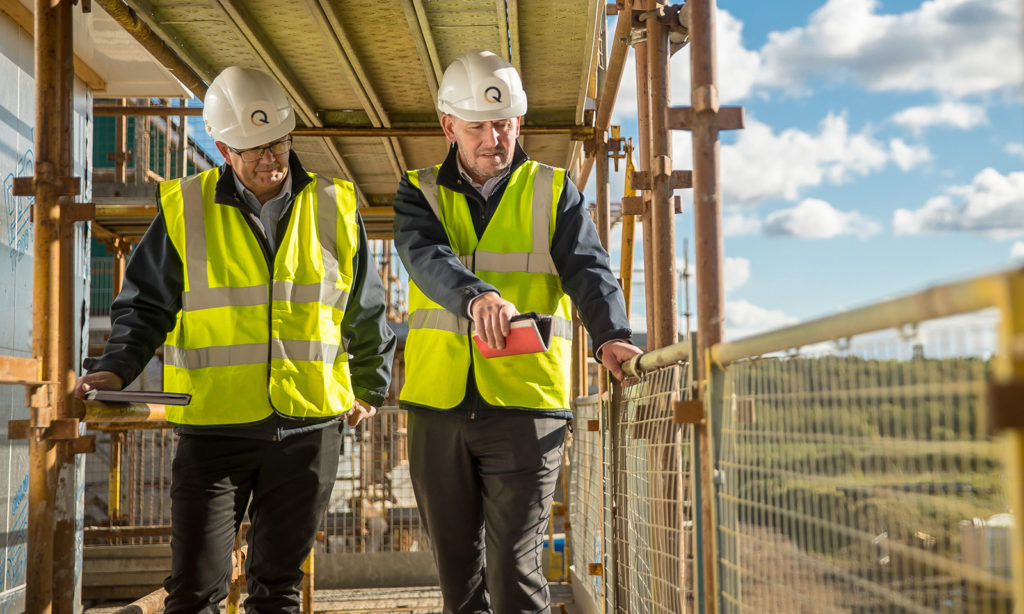Builders have a duty of care to anyone on their construction sites, which creates evolving challenges as residents move in and building work advances. In this latest article in our Insight series of in-depth analyses of all-things property, Queensberry Properties’ sales and marketing director, Hazel Davies, considers best ways to help ensure optimal on-site safety.
“Construction sites represent a unique challenge in terms of safety. These hives of activity would be relatively easy to manage if they were the exclusive domain of contractors and sub-contractors. In reality, most construction sites are also home to a marketing suite, a growing number of residents, and an ever-changing roll call of site visitors.
“Non-construction personnel might be present on-site for various reasons. This means safety is a complex, multidimensional issue which requires constant revision and supervision. First-time visitors may have little awareness of reversing cement lorries or a crane lifting a pallet of bricks nearby. Warning signage tends to be glanced at rather than studied in detail, and unless metal fencing is securely installed, after-hours visitors may meander across a site to inspect progress on their new home. Plus, each unique development layout poses different safety challenges.
“Below, we consider ways to ensure safety is optimised at all times on a construction site, from spontaneous night-time visits by curious house hunters through to managing the constant flow of trades people and delivery staff”.
Protecting official visitors
“From council inspectors to prospective purchasers, a typical building site receives numerous official visitors every week. Best to ensure anyone who will be venturing beyond the sales suite is kitted out with a helmet, safety boots and hi-vis vest, remaining in a single group and guided by a qualified sales executive or site manager. Similarly, tradespeople and delivery drivers should be escorted to their destination or given clear directions on where to park/unload/avoid. It’s also good practice to record who’s on site at any given time, with workers encouraged to be vigilant about any potentially unsafe behaviour.
“Every visitor needs to be reminded that heavy machinery is active around them, and to remain vigilant when crossing unfinished roads or pavements. Uneven surfaces are a notorious trip hazard, so it may be advisable to design a specific route visitors can follow around a part-finished site. Safety committees can help here, appointing senior first-aiders to step in should an accident occur”.
Protecting unofficial visitors
“There’s only so much you can do to prevent excitable buyers to be checking progress or simply admiring their new home after hours, peering through windows and exploring unfenced plots. However, a part-completed property may have loose components, snag points or uneven ground, posing a variety of risks and hazards. The general public can’t be expected to readily understand these dangers, so they need to be protected wherever possible.
“Ensure builders tidy up loose spoil and rubbish at the end of each day, using wheelbarrows and readily accessible waste receptacles; every employee is accountable for customer safety, and a tidy site is a safe site. Secure fencing around part-finished buildings or the periphery of an unoccupied construction area should be secured with a padlock and chains, preventing trespassers simply lifting a panel out of its base. On-site CCTV is highly advisable, with illuminated hazard sign boards warning against unauthorised access. Installing two-way video intercoms enables offsite safety personnel to communicate with visitors, encouraging them to leave”.
Protecting existing residents
“Once people start moving in, safety management becomes more complex. Residents will be receiving deliveries, house visits and utility appointments. Roads need to be routinely swept to remove shrapnel or spoil which might puncture tyres, or cause people to slip/trip. Spraying water reduces dust in dry weather, while a wheel wash for construction machinery prevents debris being dragged outside construction areas. Large (but minimalist) signage and temporary fencing should make it immediately clear to motorists and pedestrians which parts of the estate are occupied and which are not safe to park or walk on, while internal doors in apartment blocks must be clearly signposted if they’re not currently accessible.
“A 2021 UK Government study concluded that personalised letters were the most effective method of communicating with residents, which is vital for maximising awareness of forthcoming issues like road resurfacing or utility works. Good communication is always the cornerstone of site safety, until the last construction vehicle has departed and the roads have been adopted”.

